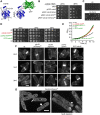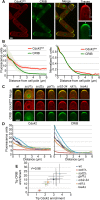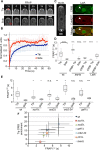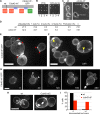Spontaneous Cdc42 polarization independent of GDI-mediated extraction and actin-based trafficking
- PMID: 25837586
- PMCID: PMC4383620
- DOI: 10.1371/journal.pbio.1002097
Spontaneous Cdc42 polarization independent of GDI-mediated extraction and actin-based trafficking
Abstract
The small Rho-family GTPase Cdc42 is critical for cell polarization and polarizes spontaneously in absence of upstream spatial cues. Spontaneous polarization is thought to require dynamic Cdc42 recycling through Guanine nucleotide Dissociation Inhibitor (GDI)-mediated membrane extraction and vesicle trafficking. Here, we describe a functional fluorescent Cdc42 allele in fission yeast, which demonstrates Cdc42 dynamics and polarization independent of these pathways. Furthermore, an engineered Cdc42 allele targeted to the membrane independently of these recycling pathways by an amphipathic helix is viable and polarizes spontaneously to multiple sites in fission and budding yeasts. We show that Cdc42 is highly mobile at the membrane and accumulates at sites of activity, where it displays slower mobility. By contrast, a near-immobile transmembrane domain-containing Cdc42 allele supports viability and polarized activity, but does not accumulate at sites of activity. We propose that Cdc42 activation, enhanced by positive feedback, leads to its local accumulation by capture of fast-diffusing inactive molecules.
Conflict of interest statement
The authors have declared that no competing interests exist.
Figures







Similar articles
-
Parallel Actin-Independent Recycling Pathways Polarize Cdc42 in Budding Yeast.Curr Biol. 2016 Aug 22;26(16):2114-26. doi: 10.1016/j.cub.2016.06.047. Epub 2016 Jul 28. Curr Biol. 2016. PMID: 27476596 Free PMC article.
-
Cdc42 regulates multiple membrane traffic events in fission yeast.Traffic. 2011 Dec;12(12):1744-58. doi: 10.1111/j.1600-0854.2011.01275.x. Epub 2011 Sep 30. Traffic. 2011. PMID: 21899677
-
Activation of Cdc42 GTPase upon CRY2-Induced Cortical Recruitment Is Antagonized by GAPs in Fission Yeast.Cells. 2020 Sep 12;9(9):2089. doi: 10.3390/cells9092089. Cells. 2020. PMID: 32932721 Free PMC article.
-
Role of Cdc42 dynamics in the control of fission yeast cell polarization.Biochem Soc Trans. 2013 Dec;41(6):1745-9. doi: 10.1042/BST20130241. Biochem Soc Trans. 2013. PMID: 24256285 Review.
-
Spontaneous cell polarization: Feedback control of Cdc42 GTPase breaks cellular symmetry.Bioessays. 2015 Nov;37(11):1193-201. doi: 10.1002/bies.201500077. Epub 2015 Sep 4. Bioessays. 2015. PMID: 26338468 Review.
Cited by
-
How cells determine the number of polarity sites.Elife. 2021 Apr 26;10:e58768. doi: 10.7554/eLife.58768. Elife. 2021. PMID: 33899733 Free PMC article.
-
Self-organization principles of intracellular pattern formation.Philos Trans R Soc Lond B Biol Sci. 2018 May 26;373(1747):20170107. doi: 10.1098/rstb.2017.0107. Philos Trans R Soc Lond B Biol Sci. 2018. PMID: 29632261 Free PMC article. Review.
-
Phosphatidylserine and GTPase activation control Cdc42 nanoclustering to counter dissipative diffusion.Mol Biol Cell. 2018 Jun 1;29(11):1299-1310. doi: 10.1091/mbc.E18-01-0051. Epub 2018 Apr 18. Mol Biol Cell. 2018. PMID: 29668348 Free PMC article.
-
The biochemical mechanism of Rho GTPase membrane binding, activation and retention in activity patterning.EMBO J. 2025 May;44(9):2620-2657. doi: 10.1038/s44318-025-00418-z. Epub 2025 Mar 31. EMBO J. 2025. PMID: 40164947 Free PMC article.
-
Parallel Actin-Independent Recycling Pathways Polarize Cdc42 in Budding Yeast.Curr Biol. 2016 Aug 22;26(16):2114-26. doi: 10.1016/j.cub.2016.06.047. Epub 2016 Jul 28. Curr Biol. 2016. PMID: 27476596 Free PMC article.
References
Publication types
MeSH terms
Substances
Grants and funding
LinkOut - more resources
Full Text Sources
Other Literature Sources
Molecular Biology Databases
Miscellaneous

